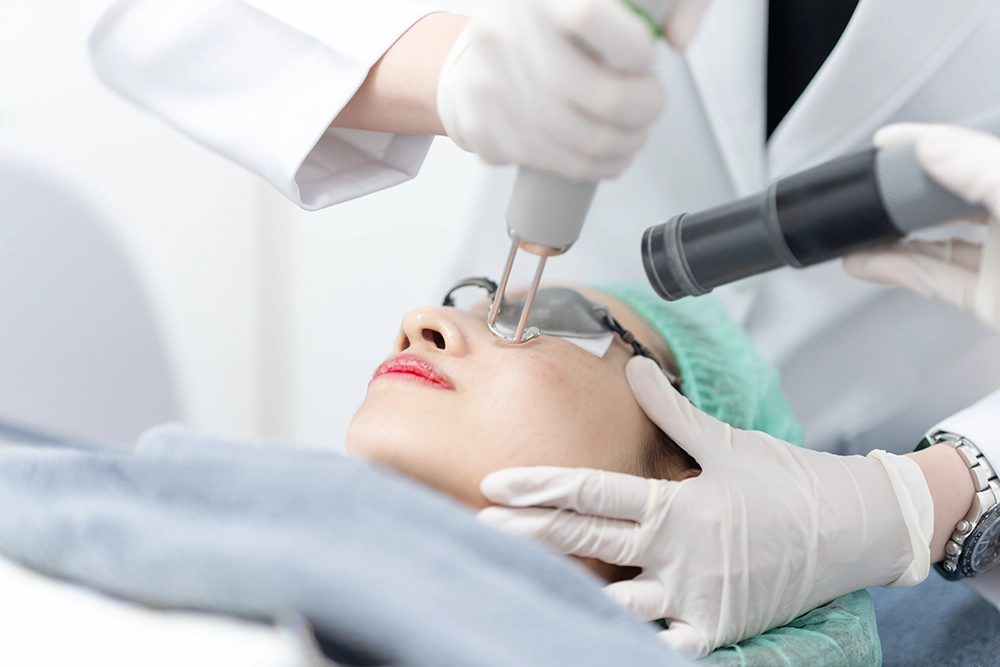Acne Laser

Have you ever wished for a way to refresh your skin, erase stubborn scars or reverse signs of aging—without invasive procedures? Laser treatments might be the answer you’re looking for. But with so many options available, how do you know which laser is right for you?
In this article, we’ll break down the science behind laser treatments, explore the different types of laser used in aesthetic medicine and help you understand how they can bring you closer to your skin goals.
How Lasers Work in Aesthetic Treatments?
Lasers are devices that emit focused light energy at specific wavelengths. In aesthetic treatments, this light energy is used to target specific structures or pigments in the skin, creating controlled damage that stimulates the skin’s natural healing process. Depending on the type of laser and the wavelength used, the light can be absorbed by pigments like melanin (for pigmentation issues) or hemoglobin (for vascular concerns), or by water in the skin (for resurfacing and collagen stimulation).
When the light energy is absorbed, it creates heat that damages the targeted cells or structures. This triggers the body’s healing response, which involves the production of new collagen and elastin, the proteins responsible for the skin’s firmness and elasticity. As the skin heals, it becomes smoother, tighter, and more evenly toned.
Lasers for Acne and Acne Scars
Fractional CO2
By creating microscopic columns of damage in the skin, the fractional CO2 laser breaks up scar tissue and stimulates the production of new collagen, which helps fill in and smooth out scars. Fractional CO2 laser treatments can improve the appearance of acne scars, with results continuing to improve for several months after the treatment.
Lasers for Pigmentation and Uneven Skin Tone
Lasers have also proven effective in the treatment of acne and acne scars. By targeting the bacteria that cause acne and resurfacing the skiPigmentation issues, such as sun spots, age spots and melasma, can be effectively treated with laser resurfacing. By targeting the pigmented cells in the skin, lasers can break up and remove excess pigment, resulting in a more even skin tone.n to reduce the appearance of scars, lasers can help patients achieve clearer, smoother skin.
Laser Resurfacing
Both ablative and non-ablative lasers can be used for laser resurfacing to address pigmentation issues. Ablative lasers, like the CO2 laser, work by vapourising the top layer of skin, removing pigmented cells and stimulating collagen production. Non-ablative lasers, such as the Q-switched laser, target specific pigments in the skin without damaging the surface, making them ideal for patients with darker skin tones or those who cannot afford extensive downtime.
Lasers for Scar and Stretch Mark Treatments
Scars and stretch marks can be challenging to treat, but lasers offer a solution for improving their appearance. By resurfacing the skin and stimulating collagen production, lasers can help smooth out and fade scars and stretch marks.
Fractional CO2 Lasers
Lasers for Tattoo Removal
Pico Laser
Choosing the Right Laser Treatment for Your Skin Concerns
Factors to Consider
Skin type
Specific concern
Downtime
Budget
Is Laser Treatment Painful?
One of the most common concerns patients have about laser treatments is whether they are painful. The level of discomfort experienced during a laser treatment depends on the type of laser, the depth of penetration and the individual’s pain tolerance. Most patients describe the sensation as a mild to moderate snapping or burning feeling, similar to a rubber band snapping against the skin.
To minimise discomfort, aesthetic doctors often use numbing creams or local anesthesia before the treatment. Some lasers also have built-in cooling systems that help soothe the skin during the procedure. In most cases, patients find laser treatments tolerable and feel that the temporary discomfort is worth the results.
Recovery after Laser Treatment
The recovery process after a laser treatment varies depending on the type of laser and the individual’s healing response. In general, patients can expect some degree of redness, swelling, and discomfort in the treated area, which can last from a few hours to several days.
For ablative laser treatments like the CO2 laser, the recovery time is typically longer, as the top layer of skin needs to heal. Patients may experience more significant redness, swelling, and peeling, and may need to take a few days off work to recover. Non-ablative laser treatments generally have a shorter recovery time, with most patients able to return to their normal activities immediately after the treatment.
Regardless of the type of laser treatment, it is crucial to follow your doctor’s post-treatment instructions carefully. This may include avoiding sun exposure, using gentle skincare products, and keeping the treated area moisturised. Proper aftercare can help minimise the risk of complications and ensure optimal results.
Ready to Transform Your Skin with Laser Treatments?
Laser treatments offer a versatile solution for a wide range of skin concerns, from aging and acne to pigmentation, scars and tattoos. At DermClear, we are dedicated to providing our clients with personalised treatment plans that addresses their unique skin concerns and goals.
Contact DermClear today to schedule your consultation and discover how laser treatments can transform your skin and boost your confidence.
Sculpt the Body You Want–Feel Confident in Your Skin
Our friendly team is looking forward to serving you. For urgent enquiries and appointment requests, please call the clinic directly.